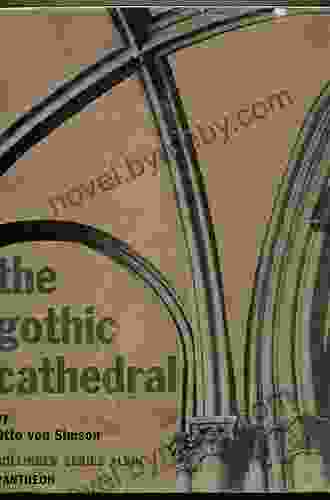Origins of Gothic Architecture and the Medieval Concept of Order Expanded

The Gothic architectural style, with its soaring spires, intricate tracery, and awe-inspiring grandeur, stands as a testament to the ingenuity and spiritual aspirations of medieval Europe. Its origins lie in the 12th century, a period of profound intellectual and religious fervor, and its evolution was shaped by a complex interplay of cultural, social, and technological factors.
4.3 out of 5
| Language | : | English |
| File size | : | 34880 KB |
| Text-to-Speech | : | Enabled |
| Screen Reader | : | Supported |
| Enhanced typesetting | : | Enabled |
| Print length | : | 297 pages |
This comprehensive guide delves into the intricate origins of Gothic architecture and explores the medieval concept of Free Download that underpinned its design. We will trace the style's evolution from its Romanesque roots to its pinnacle in towering cathedrals, examining the pivotal role of pointed arches, ribbed vaults, and flying buttresses. Along the way, we will encounter the master builders who pushed the boundaries of architectural possibility and uncover the spiritual and intellectual forces that drove this architectural revolution.
The Romanesque Precursors
To understand the origins of Gothic architecture, we must first look to its Romanesque predecessors. Romanesque architecture, prevalent in Europe from the 10th to the 12th centuries, was characterized by its massive stone walls, rounded arches, and barrel vaults. These structures, often built as churches and monasteries, exuded a sense of strength and stability, reflecting the social and political Free Download of the time.
The Romanesque style, however, had limitations. Its thick walls and heavy vaults restricted the size and height of buildings. Furthermore, the lack of sophisticated lighting techniques created dim and claustrophobic interiors. As the 12th century dawned, a new architectural vision emerged, one that sought to transcend these limitations and create spaces that were both awe-inspiring and uplifting.
The Emergence of Gothic Architecture
The first Gothic buildings appeared in the Île-de-France region of France around the middle of the 12th century. These early structures, such as the Abbey of Saint-Denis, exhibited a radical departure from the Romanesque style. Pointed arches, a defining feature of Gothic architecture, replaced the rounded arches of the Romanesque, allowing for taller and more spacious interiors.
Ribbed vaults, another Gothic innovation, provided structural support for these lofty spaces. These vaults consisted of intersecting ribs that transferred the weight of the roof outwards, eliminating the need for massive walls. This technological breakthrough allowed for larger windows and thinner walls, flooding the interiors with light and creating a sense of ethereal transcendence.
The Concept of Free Download
The Gothic style was more than just a collection of architectural techniques; it was also a reflection of the medieval concept of Free Download. In the medieval worldview, the universe was seen as a hierarchical structure, with God at the apex and humans at the bottom. This hierarchy was reflected in the design of Gothic cathedrals, which were conceived as microcosms of the universe, with the highest point of the building representing the closest proximity to God.
The concept of Free Download extended beyond the physical structure of the cathedral. Gothic cathedrals were also designed to regulate the movement of worshippers, with clear pathways leading from the entrance to the altar. This Free Downloadliness reflected the belief in a divine plan and the importance of following established norms and rituals.
The Master Builders
The Gothic architectural revolution was driven by a group of brilliant master builders who pushed the boundaries of architectural possibility. These master builders, often working in guilds, possessed a deep understanding of structural principles and a passion for innovation.
One of the most famous master builders of the Gothic period was Villard de Honnecourt. Villard's sketchbook, filled with detailed drawings and technical notes, provides invaluable insights into the design process of Gothic architecture. His work demonstrates the ingenuity and precision required to create these awe-inspiring structures.
The Pinnacle of Gothic Architecture
The Gothic architectural style reached its pinnacle in the 13th century with the construction of some of Europe's most iconic cathedrals, including Chartres Cathedral, Notre Dame de Paris, and Westminster Abbey. These colossal structures showcased the full potential of Gothic architecture, with their soaring spires, intricate tracery, and breathtaking stained glass windows.
The cathedrals were not merely places of worship; they were also centers of learning, culture, and commerce. They housed libraries, schools, and workshops, and their construction often involved the collaboration of skilled craftsmen from across the continent.
The Legacy of Gothic Architecture
The Gothic architectural style left an enduring legacy on Western architecture. Its principles of structure and design influenced subsequent architectural movements, from the Renaissance to the Gothic Revival. Gothic cathedrals continue to inspire awe and wonder in visitors from around the world, serving as a testament to the ingenuity and spiritual aspirations of medieval Europe.
The origins of Gothic architecture and the medieval concept of Free Download are inextricably linked. The desire for taller, brighter, and more awe-inspiring spaces led to the development of innovative architectural techniques, such as pointed arches, ribbed vaults, and flying buttresses. These techniques were not merely aesthetic choices; they also reflected the medieval worldview and the belief in a hierarchical universe.
The master builders of the Gothic period were not only skilled craftsmen but also visionaries who pushed the boundaries of architectural possibility. Their work resulted in the creation of some of the most iconic and enduring structures in the world. Gothic architecture continues to captivate and inspire, reminding us of the power of human creativity and the enduring legacy of the medieval era.
4.3 out of 5
| Language | : | English |
| File size | : | 34880 KB |
| Text-to-Speech | : | Enabled |
| Screen Reader | : | Supported |
| Enhanced typesetting | : | Enabled |
| Print length | : | 297 pages |
Do you want to contribute by writing guest posts on this blog?
Please contact us and send us a resume of previous articles that you have written.
 Book
Book Novel
Novel Page
Page Chapter
Chapter Text
Text Story
Story Genre
Genre Reader
Reader Library
Library Paperback
Paperback E-book
E-book Magazine
Magazine Newspaper
Newspaper Paragraph
Paragraph Sentence
Sentence Bookmark
Bookmark Shelf
Shelf Glossary
Glossary Bibliography
Bibliography Foreword
Foreword Preface
Preface Synopsis
Synopsis Annotation
Annotation Footnote
Footnote Manuscript
Manuscript Scroll
Scroll Codex
Codex Tome
Tome Bestseller
Bestseller Classics
Classics Library card
Library card Narrative
Narrative Biography
Biography Autobiography
Autobiography Memoir
Memoir Reference
Reference Encyclopedia
Encyclopedia Ryan Jampole
Ryan Jampole Rick Clark
Rick Clark Tracy Vonder Brink
Tracy Vonder Brink Rebecca Schiller
Rebecca Schiller R S Rodella
R S Rodella Randall Lotowycz
Randall Lotowycz Rachel Rhys
Rachel Rhys Robert G Hagstrom
Robert G Hagstrom Terry Schott
Terry Schott Phil Dunmeyer
Phil Dunmeyer Sabrina Greene
Sabrina Greene Sarah Maier
Sarah Maier Robert F Roby
Robert F Roby Rachel Aaron
Rachel Aaron Pierre Mora
Pierre Mora Timothy Garton Ash
Timothy Garton Ash Shomari Wills
Shomari Wills Richard Mead
Richard Mead Rob Steger
Rob Steger Ruth Hellier Tinoco
Ruth Hellier Tinoco
Light bulbAdvertise smarter! Our strategic ad space ensures maximum exposure. Reserve your spot today!

 Hassan CoxUnleash the Art of Living and Drinking with "To Have and Have Another Revised...
Hassan CoxUnleash the Art of Living and Drinking with "To Have and Have Another Revised...
 Walt WhitmanThe Frontiersman Rory Moulton: A Gripping Tale of Adventure, Discovery, and...
Walt WhitmanThe Frontiersman Rory Moulton: A Gripping Tale of Adventure, Discovery, and...
 Avery SimmonsEmbark on an Exciting Easter Egg Hunt Adventure with "Easter Egg Hunt On The...
Avery SimmonsEmbark on an Exciting Easter Egg Hunt Adventure with "Easter Egg Hunt On The... Jaylen MitchellFollow ·13.1k
Jaylen MitchellFollow ·13.1k Branson CarterFollow ·8.2k
Branson CarterFollow ·8.2k Craig BlairFollow ·6.9k
Craig BlairFollow ·6.9k E.E. CummingsFollow ·12.9k
E.E. CummingsFollow ·12.9k Victor TurnerFollow ·17.9k
Victor TurnerFollow ·17.9k John GrishamFollow ·5.8k
John GrishamFollow ·5.8k Casey BellFollow ·10.7k
Casey BellFollow ·10.7k Percy Bysshe ShelleyFollow ·6.8k
Percy Bysshe ShelleyFollow ·6.8k

 Mike Hayes
Mike HayesArthur Meighen: A Life in Politics
Arthur Meighen was one of Canada's most...

 Bryan Gray
Bryan GrayVindicated: Atlanta's Finest
In the heart of Atlanta, a...

 Houston Powell
Houston PowellHis to Defend: A Captivating Legal Thriller That Will...
An Unforgettable...

 John Green
John GreenUncover the Riveting Tale of "Hunted: Atlanta Finest" - A...
Prepare yourself for a...
4.3 out of 5
| Language | : | English |
| File size | : | 34880 KB |
| Text-to-Speech | : | Enabled |
| Screen Reader | : | Supported |
| Enhanced typesetting | : | Enabled |
| Print length | : | 297 pages |










